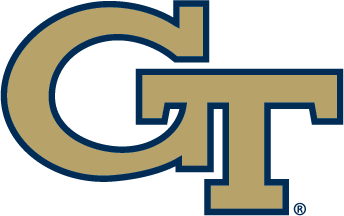Chris Petefish closed out his collegiate career by shooting 69.
By Matt Winkeljohn | The Good Word
– There are times when golf doesn’t make sense or look entirely like sport, but that doesn’t make it easier for Bruce Heppler to process Georgia Tech’s NCAA regional fate.
The Yellow Jackets have missed out on the NCAA championships just five times in 28 years since regionals came into play. Yet for the third consecutive season Tech Wednesday went home early.
For the second straight year, the No. 4 Jackets (17-under par 835) fell one stroke short of the fifth and final qualifying spot behind Texas (813), Duke (830), N.C. State (831), Augusta (832) and Arizona State (834).
Again, the pivot point came down to the final hole of the three-day tournament, this time at the Lonnie Poole Golf Course in Raleigh, N.C.
Tech logged four pars and a bogey at the last, where Arizona State logged four pars and a birdie to leapfrog the Jackets and yank the final spot out in Raleigh away from them. Last year at Stanford, Tech logged two bogeys at the last, enabling ACC rival North Carolina to vault into the fifth spot.
This time, ACC foes Duke and N.C. State, the Wolfpack playing on their home course and Duke not so unfamiliar with it, sailed to nationals ahead of the Jackets.
So imagine Heppler’s state of mind after his No. 4-ranked team, which won four tournament titles this year, including the program’s 17th ACC crown, after the Jackets couldn’t punch one of 30 tickets from regionals to NCAAs.
And four ACC teams — Clemson, Duke, N.C. State and North Carolina — did.
“Not real good because it’s two in a row. That’s nasty,” Heppler said Thursday. “I don’t care about the other stuff. We’re all measured by the postseason. We played way better than everybody else [over the school year] and we’re on our way home again.”
The last-hole drama was only the last of considerable madness, much of that attributable to the Jackets playing a lot of good but no great golf on a course where low scores were available.
We’ll get to that, but this seems a good spot to transition to commentary and question.
Why does college golf drop one score from every team after every round and count the scores of only four of five players? Anybody know any other sports that do this?
The questions arise both because the process seems drunken, and because if the scores of all five golfers for every team counted every day, Tech would’ve tied N.C. State for third place, two strokes ahead of Arizona State. Augusta would’ve finished sixth, five back of the Jackets.
Golf itself is a risk/reward, payoff/punishment sport. You make a good decision and play it well, you’re in better position for the next. Make a bad decision, or play it poorly, you’ll be punished on the scorecard.
Why eliminate punitive elements?
Golf coaches take pride in having a low drop score average because it indicates talented depth.
Tech has depth. Their three drop scores at the 7,273-yard, par-71 course were 70-74-72=216. That composite was three strokes better than the composites of any other team in the tournament.
The Jackets’ low finisher was sophomore Luke Schniederjans, who tied for 32nd in a field of 75.
Augusta’s second-, third-, fourth- and fifth-placers finished T32, T40, T40 and T59.
All of Tech golfers finished equal to or better than four of Augusta’s five.
This tournament came down to scoring, and on the course, Tech’s shortage of super scores. Sophomore Tyler Strafaci led the way, tying for 13th at 5-under par 208, although his bogey on the final hole hurt.
Texas, Duke and N.C. State each had two top-10 finishers. Augusta and Arizona State each had one, and Duke and Arizona State each had a golfer tie Strafaci as well. All of that helped Texas offset a T47, Duke a T55, NC State two T57s and Arizona two T47s.
“We didn’t have a guy anywhere near the lead,” Heppler said. “The fact that we won the ACC Tournament is a miracle with no one in the top 10. We have really good players. We need people to be great players. Somebody’s got to go to the next level.”
It helps when you can throw out the scores of your duffers.
Tech was in second place after the first round and in third place after the second.
Over the course of the tournament, “We stopped making birdies,” Heppler said.
And the Jackets struggled with the short holes.
On a course where there were birdies waiting, the Jackets led the field — here counting all five players — on the par 4 holes, playing them in a combined three-under par. They were fourth on the par fives, playing them in -16. On the par threes, they were 10th at five-over.
And they didn’t have the benefit of timing or super low scores, like Augusta in particular.
In the third round, Augusta started 12 back of the Jackets and wound up three shots ahead of Tech in part because Olaf Gunarsson fired a 66. His teammates went 66-68-70-71 and with the drop score they carded a stellar 270, the second-lowest round of the tournament.
Augusta, whom Tech beat by 47 strokes and finished second to host Arizona State by a stroke in the second tournament of the fall season, the Maui Jim Intercollegiate at ASU in September, was rewarded for Gunarsson’s play.
But the Jaguars were not punished in the first and second rounds when he shot 74-79. Those scores were dropped.
Heppler declined to point a finger at his sport’s scoring system. If all five counted, Clemson would’ve won the ACC championship last month by a stroke over the Jackets rather than finishing two back.
He just said his team needs to score better.
Tech’s best rounds in the tournament came on Monday, when Strafaci, Schniederjans and senior Chris Petefish each fired 68.
Texas, whom Tech beat twice earlier this season, had five better rounds and one equal. Duke had two better and two equal. N.C. State had two better and one equal. Augusta had four better and one equal. Arizona State had three better and one equal.
That’s 17 rounds that bettered Tech’s best.
Tech was the only team in the 14-team field – each team includes five individuals – that had every golfer finish the tournament under par for 54 holes.
But they didn’t have enough super scores, and the way their sport is scored multiplies the reward for super scores vs. a disparate shortage of penalty for at least one poor one in every round.
Gunarsson’s first two rounds didn’t hurt Augusta. Yet when teammate Broc Everett went 67-66-66 to finish second behind Texas’ Doug Ghim (64-66-66), who last summer was runner-up in the U.S. Amateur and last fall won Tech’s Golf Club of Georgia Collegiate, it sure helped.
“We have to find some guys who can play on the lead,” Heppler said. “I think this will probably going to be the third year in a row we don’t have an All-American on the team … we’ve always had that.”









